Driveline
Balancing efficiency and durability
20 May 2025
23 January 2024
Protecting the next generation of electrified vehicles drives the development of tailored driveline e-fluids
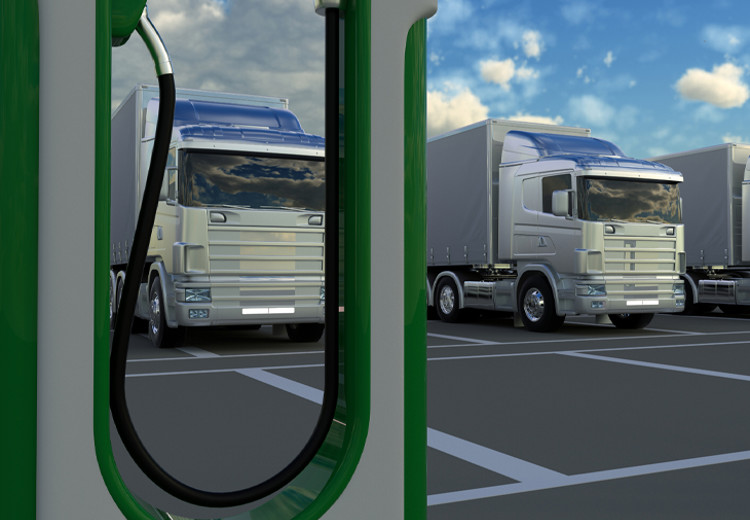
As the transportation industry works to decarbonise, commercial vehicle manufacturers are exploring a range of low and zero carbon propulsion options, including electrification. Callum Sugden and Andrew Wood, Infineum Driveline Fluid Technologists, explain how, as the electrified truck and bus market develops, new opportunities are arising to formulate tailored driveline e-fluids to deliver the specific protection and performance needs of the evolving electric drive architectures used in this vehicle segment.
To meet decarbonisation targets many commercial vehicle OEMs are increasingly including models running on low and zero carbon energy sources in their vehicle portfolios. Full battery electric propulsion is one option, and in 2021 it was estimated that just over 4% of the combined global bus and truck fleet was fully electric. Looking ahead, as the pressure to decarbonise intensifies, forecasters suggest that by 2029 some 10% of commercial vehicles rolling off the production line will be electric, with the majority produced in China, and small volumes coming from Europe and North America.
The generally shorter trips along with return to base operation, which enables overnight charging, plus local government measures to reduce air pollution in city centres, makes the transition less difficult for buses.
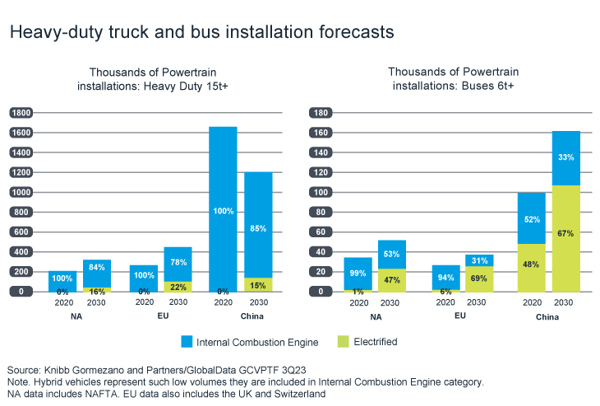
Data suggests a faster electrification rate of buses compared to heavy-duty trucks
As the hardware evolves we can expect to see three key drive systems in the market - central drive, integrated e-axle and distributed wheel/specific hub motors.
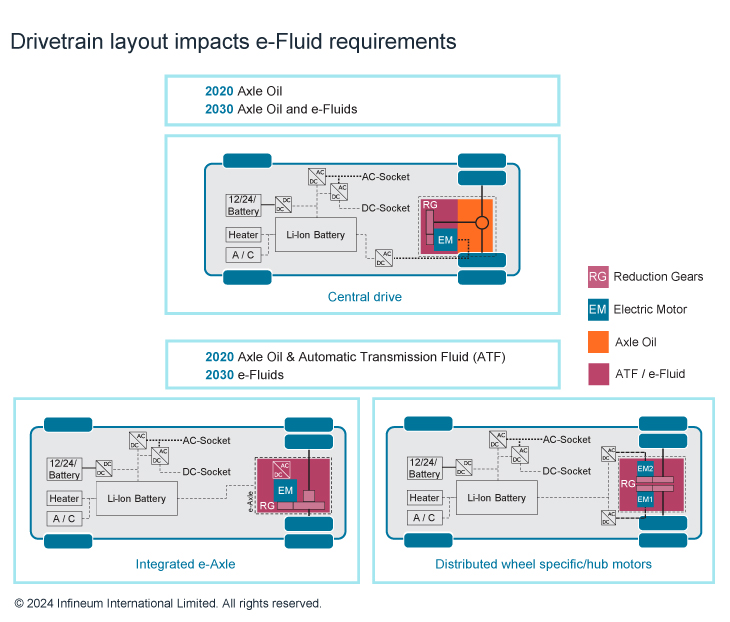
The gear type and position of the motor means it is challenging for one fluid to meet all the requirements of these systems. In most cases today, two separate fluids are used in these applications – one to cool the motor the other to protect the gears.
It is also challenging to deliver sufficient hardware protection in these fully electric models with the conventional automatic transmission fluids (ATF) and axle oils used today.
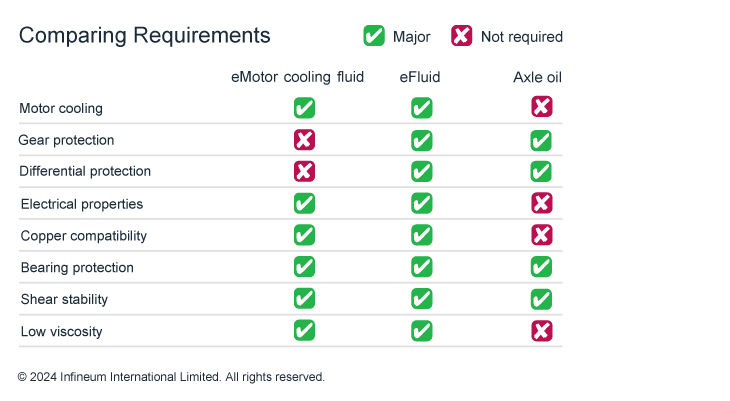
The different electric drive architectures used in commercial vehicles need more advanced formulations. The central drive requires axle oils and e-fluids, while the integrated e-axle and distributed wheel specific/hub motor architectures can best be served by tailored e-fluids.
Next generation e-fluids will need to deliver not only traditional transmission fluid properties but also new e-fluid requirements including improved heat transfer, better materials compatibility and higher volume resistivity. In the future, we can expect fluid requirements to be driven by e-motor compatibility, efficiency improvement and the use of hypoid or helical gears.
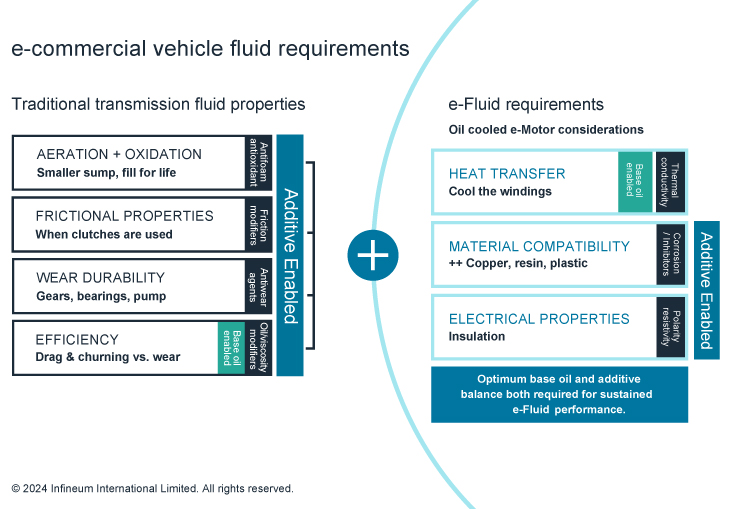
Cooling electric motors is recognised as a critical function of electric vehicle transmission fluids. Infineum has carried out extensive assessments to determine the most important properties of e-fluids with respect to heat transfer. While the impact of viscosity and additive technology have been key focal points during tests carried out in different motor configurations, attention has also been directed towards the effect of operating conditions such as flow rate and motor torque.
Heat generation tests revealed that low viscosity fluids offer significant performance benefits vs. higher viscosity formulations – delaying derating of stator windings and showing lower steady state temperatures. However, when moving to lower viscosity lubricants it is important that the cooling benefits provided are balanced by an additive technology that also delivers sufficient wear protection.
e-motors introduce a wide range of materials into the drivetrain including insulating material, copper wire and connections, aluminium, plastics and sealants.
Since electronic circuit boards are increasingly in contact with or immersed in oil, many OEMs consider full copper compatibility to be one of the most important design parameters for e-fluids.
The ASTM D130 procedure is one of the most common methods used to study the impact of copper corrosion. But now newer methods, including energised circuit board tests that involve the passage of an electric current, are also being used to better understand copper corrosion. In addition, thermal shock testing is a useful way to evaluate compatibility with other materials, including varnished wire and a range of insulation materials, under extreme thermal cycling conditions.
Using these tests, Infineum’s e-fluid and e-motor cooling fluids have shown outstanding motor materials compatibility performance.
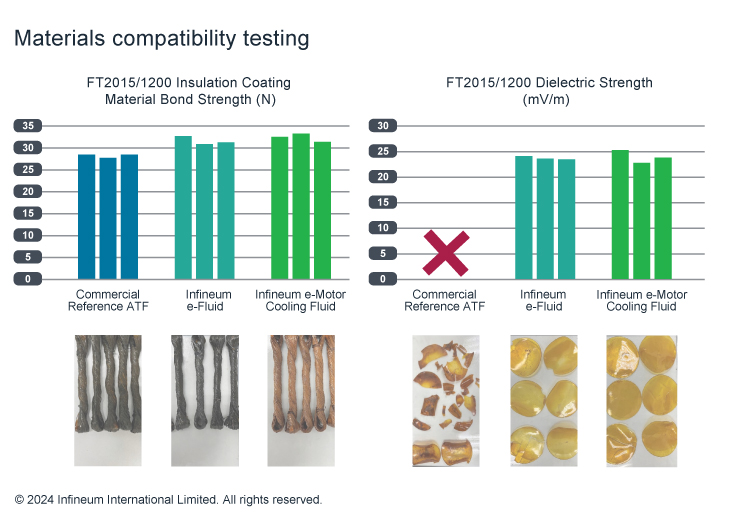
Infineum e-fluid and e-motor cooling fluids demonstrate outstanding motor materials compatibility performance
The issue of electrical compatibility overarches all electric vehicle developments. The power electronics operate at hundreds of volts, which means the fluid needs to provide enough resistivity to avoid any current leakage and/or electrical shorts. However, if the fluid is completely insulating, it can lead to static charge buildup which can damage the equipment due to arcing phenomena. e-fluids designed with optimal resistivity can help OEMs to reduce the size of the motor and casing, which means less material use and lower production costs, and can enable the use of even higher voltages.
In our view, it is important to tailor e-fluid formulations for commercial vehicles to ensure they deliver the right balance of performance to meet individual customer needs.
e-fluids need to provide both high gear scuffing and high volume resistivity performance making a tailored e-fluid a good fit for use in these applications.
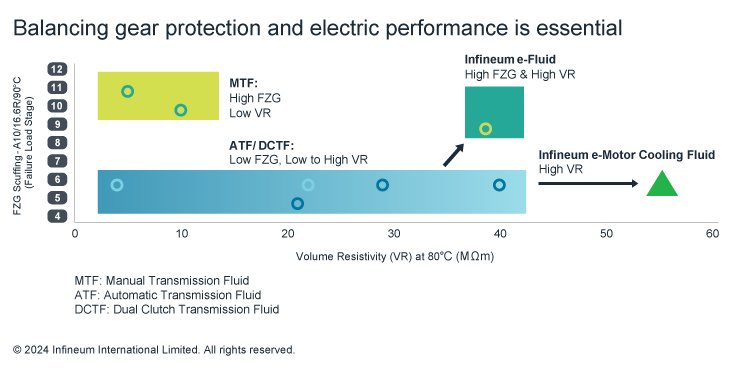
A careful balance of additive components and base stock is needed to create tailored e-fluids that deliver the required cooling, electrical performance and materials compatibility electrified commercial vehicles require. But, at the same time, these complex fluids must also meet gear and bearing durability, aeration and efficiency requirements.
Infineum e-fluids have demonstrated improvements in electrical performance, material compatibility and motor cooling efficiency via modelling, novel test methods, e-motor rig testing and field trials in electrified applications. As we look to the future, where in commercial vehicles traditional transmission fluids will be replaced by advanced e-fluids, Infineum is ready with tailored solutions that are aligned with evolving hardware designs.
Sign up to receive monthly updates via email